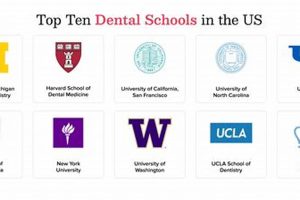Top-tier aviation training institutions in the United States offer comprehensive programs designed to prepare aspiring pilots for careers in various sectors of the aviation industry. These programs typically encompass both ground school instruction, covering theoretical subjects like meteorology, navigation, and regulations, and flight training, providing practical experience in operating aircraft. For example, a curriculum might include simulator sessions for instrument training and numerous hours of in-flight instruction with certified flight instructors, culminating in certifications and ratings like Private Pilot License (PPL), Commercial Pilot License (CPL), and Airline Transport Pilot License (ATPL).
High-quality aviation education plays a vital role in maintaining the safety and efficiency of air travel. Rigorous training programs ensure pilots possess the necessary skills and knowledge to operate aircraft safely, navigate complex airspace systems, and respond effectively to emergencies. Historically, the demand for skilled pilots has been consistently high, and reputable flight schools have played a crucial role in meeting this need by supplying the industry with competent professionals. Furthermore, the development and advancement of aviation technology necessitates continuous adaptation in training methodologies and curricula, making ongoing investment in quality flight education essential.
This article will delve deeper into the key elements that distinguish exceptional flight training programs, explore factors prospective students should consider when selecting a school, and provide a closer look at some leading aviation academies across the nation.
Tips for Selecting a Top Flight School
Choosing the right flight training institution is a critical decision for aspiring pilots. Careful consideration of various factors can significantly impact training outcomes and career prospects. The following tips provide guidance for navigating the selection process effectively.
Tip 1: Accreditation and Certifications: Verify that the institution holds relevant accreditations from recognized aviation authorities. Accreditation ensures adherence to established industry standards and quality benchmarks.
Tip 2: Curriculum Breadth and Depth: Examine the curriculum to ensure it covers required theoretical knowledge and provides ample practical flight training hours. A comprehensive curriculum should encompass various aspects of aviation, including meteorology, navigation, and regulations.
Tip 3: Instructor Qualifications and Experience: Research the qualifications and experience of the flight instructors. Experienced and certified instructors can provide valuable guidance and mentorship.
Tip 4: Fleet Composition and Maintenance: Assess the condition and variety of aircraft in the flight school’s fleet. Modern, well-maintained aircraft contribute to a safer and more effective learning environment.
Tip 5: Safety Record and Practices: Inquire about the flight school’s safety record and procedures. A strong emphasis on safety protocols is crucial for minimizing risks during training.
Tip 6: Cost and Financing Options: Evaluate the overall cost of training, including fees for flight hours, ground school instruction, and materials. Explore available financing options and scholarship opportunities.
Tip 7: Location and Facilities: Consider the location of the flight school and the availability of suitable training airspace. Modern facilities and equipment can enhance the learning experience.
By carefully considering these factors, prospective pilots can make informed decisions and select a flight school that aligns with their individual training needs and career goals. A well-chosen training program provides a solid foundation for a successful and rewarding career in aviation.
These tips offer a starting point for the crucial process of selecting a flight school. The following section will conclude with a summary of key takeaways and further resources for prospective pilots.
1. Accreditation
Accreditation serves as a critical differentiator in identifying top-tier flight schools within the United States. Reputable accrediting bodies, such as the Aviation Accreditation Board International (AABI), rigorously evaluate flight training institutions based on stringent criteria encompassing curriculum quality, instructor qualifications, safety practices, and facilities. Schools earning accreditation demonstrate a commitment to meeting industry standards and providing high-quality education. This strong correlation between accreditation and program excellence positions accredited institutions as preferred choices for aspiring pilots. For instance, a flight school accredited by AABI signals to prospective students, airlines, and other aviation employers that the institution adheres to established best practices and produces graduates well-prepared for professional careers. This recognition significantly enhances graduates’ employment prospects and contributes to the overall professionalism of the aviation industry.
The impact of accreditation extends beyond curriculum and instructor standards. It influences the acceptance of flight training credits for transfer between institutions, simplifying educational pathways for students. Furthermore, accredited schools often benefit from industry partnerships and access to advanced training resources, enriching the learning experience. For example, partnerships with airlines can lead to internship opportunities and preferential hiring pathways for graduates of accredited programs. This practical advantage underscores the long-term value of choosing an accredited institution. Conversely, lack of accreditation can signal potential shortcomings in educational quality and may limit career opportunities for graduates.
In summary, accreditation plays a pivotal role in shaping the landscape of flight training excellence. It provides quality assurance, enhances career prospects, and fosters industry partnerships. Prospective pilots seeking the best flight schools in the USA should prioritize accredited institutions as a key factor in their decision-making process. This focus on accreditation ensures a robust educational foundation and maximizes opportunities for a successful aviation career.
2. Curriculum Rigor
A rigorous curriculum distinguishes top flight schools in the USA, preparing graduates for the complexities of the aviation industry. Comprehensive programs go beyond basic flight instruction, incorporating advanced concepts and practical training essential for professional success. Understanding key facets of curriculum rigor provides valuable insights for prospective pilots.
- Ground School Foundation:
Robust ground school instruction lays the theoretical groundwork for practical flight training. Topics such as meteorology, navigation, aerodynamics, and regulations provide essential knowledge for safe and efficient flight operations. For instance, in-depth meteorology training equips pilots to interpret weather patterns and make informed decisions during flight. Strong ground school programs utilize advanced teaching methods and resources, including simulations and interactive learning modules, enhancing student comprehension.
- Flight Training Structure:
Structured flight training programs progress logically from basic maneuvers to complex operations. Clear learning objectives and performance standards guide student development. For example, initial training might focus on basic aircraft control, followed by navigation, instrument flying, and multi-engine operations. Well-defined milestones and regular assessments ensure students acquire necessary skills progressively.
- Specialized Training Integration:
Leading flight schools integrate specialized training to prepare graduates for diverse career paths. This can include instruction in areas such as upset recovery training, high-altitude operations, or specific aircraft type ratings. For instance, incorporating upset recovery training equips pilots with the skills to handle unusual flight attitudes and prevent loss of control. Specialized training enhances marketability and career flexibility.
- Emphasis on Safety Practices:
Curriculum rigor extends to an unwavering focus on safety. Flight schools prioritize safety management systems (SMS) and instill a strong safety culture throughout training. For example, integrating scenario-based training exposes students to realistic emergency situations, promoting effective decision-making under pressure. Rigorous safety practices contribute to accident prevention and enhance pilot professionalism.
These interconnected facets of curriculum rigor directly impact the quality of flight training and, ultimately, the success of graduates. Top flight schools in the USA demonstrate a commitment to rigorous training standards, equipping pilots with the knowledge, skills, and professionalism required for rewarding careers in aviation. By prioritizing curriculum rigor, these institutions contribute significantly to the safety and efficiency of the aviation industry as a whole.
3. Instructor Expertise
Instructor expertise stands as a cornerstone of exceptional flight training. The quality of instruction directly impacts student learning, safety, and overall program effectiveness. Top flight schools in the USA prioritize recruiting and retaining highly qualified instructors who possess a blend of experience, pedagogical skill, and commitment to aviation education. This emphasis on instructor expertise differentiates leading institutions and contributes significantly to positive student outcomes.
- Certified Flight Instructor Qualifications:
Certified Flight Instructors (CFIs) at reputable flight schools hold certifications issued by regulatory bodies like the Federal Aviation Administration (FAA). These certifications validate their knowledge and proficiency in various aspects of flight instruction. Beyond minimum certification requirements, top schools often seek instructors with advanced ratings, such as instrument, multi-engine, and commercial flight instructor certifications. These additional qualifications demonstrate a higher level of expertise and allow instructors to provide comprehensive training across a broader spectrum of pilot certifications. For example, a CFI with an Airline Transport Pilot (ATP) certificate brings extensive real-world experience to the classroom and flight training environment.
- Real-World Flight Experience:
Instructors with substantial real-world flight experience provide invaluable insights and practical knowledge to students. Experience in diverse aviation sectors, such as commercial airlines, charter operations, or military aviation, enriches the learning process. For instance, an instructor with prior airline experience can offer firsthand knowledge of airline procedures and operations, preparing students for airline pilot careers. This practical experience complements theoretical knowledge, bridging the gap between classroom learning and real-world application.
- Instructional Proficiency:
Effective instruction requires more than just technical expertise; it demands strong pedagogical skills. Top flight schools prioritize instructors who demonstrate clear communication, patience, and adaptability. They employ proven instructional techniques to cater to diverse learning styles and provide personalized feedback. Regular professional development and training for instructors ensure they stay abreast of the latest aviation advancements and instructional methodologies. This commitment to continuous improvement enhances the overall quality of instruction and contributes to positive student learning outcomes.
- Dedication to Student Success:
Leading flight schools cultivate an environment where instructors are genuinely invested in student success. This dedication goes beyond simply delivering course content; it encompasses mentorship, guidance, and support throughout the training journey. Instructors in top programs act as mentors, providing personalized advice and helping students navigate the challenges of flight training. This supportive learning environment fosters student confidence and promotes a positive training experience. Ultimately, instructors’ dedication to student success plays a crucial role in shaping well-rounded, competent pilots.
The convergence of these facets of instructor expertise contributes significantly to the overall excellence of flight training programs. Prospective pilots seeking the best flight schools in the USA should carefully evaluate the qualifications, experience, and instructional approach of the instructors. A strong instructional team signifies a commitment to quality education and enhances the likelihood of successful outcomes for aspiring aviators. By prioritizing instructor expertise, these institutions invest in the future of the aviation industry by nurturing the next generation of skilled and competent pilots.
4. Advanced Fleet
A modern, well-maintained, and diverse fleet constitutes a critical component of top-tier flight schools in the USA. The quality and composition of training aircraft directly influence the effectiveness of flight instruction, student learning outcomes, and preparedness for real-world aviation careers. A correlation exists between advanced fleets and the overall caliber of flight training programs. Advanced aircraft equipped with modern avionics and technology provide students with hands-on experience with the systems and equipment they will encounter in professional aviation settings. This exposure bridges the gap between training and real-world operations, enhancing graduates’ competitiveness and preparedness for airline or other advanced flight operations. For example, training on aircraft equipped with glass cockpits and advanced navigation systems provides a significant advantage for graduates seeking employment in airlines that operate modern aircraft. Conversely, training primarily on older, less sophisticated aircraft may leave graduates less prepared for the technological demands of contemporary aviation.
The diversity of an advanced fleet also plays a crucial role in comprehensive flight training. Exposure to various aircraft types, including single-engine, multi-engine, and complex aircraft, broadens students’ skill sets and adaptability. This varied experience allows for a more comprehensive understanding of aircraft performance characteristics and handling qualities. For instance, a flight school with a diverse fleet might include aircraft ranging from basic trainers to sophisticated multi-engine aircraft with advanced avionics. This range allows students to progress through increasingly complex aircraft as they advance in their training, culminating in experience with aircraft similar to those used in commercial operations. This progressive training approach better prepares graduates for the challenges and demands of diverse aviation career paths. Furthermore, access to advanced simulators complements the flight training experience, offering opportunities to practice complex procedures and emergency scenarios in a safe and controlled environment.
In summary, the presence of an advanced and diverse fleet signifies a flight school’s commitment to providing high-quality, relevant training. This investment in modern equipment and technology directly translates to enhanced learning outcomes and improved career prospects for graduates. The composition and maintenance of a flight school’s fleet serve as key indicators of its commitment to preparing students for successful careers in the evolving landscape of the aviation industry. Therefore, prospective pilots should prioritize flight schools with advanced fleets as a critical factor in their selection process. This focus on advanced training equipment ensures access to the latest technology and maximizes preparedness for a dynamic and technologically driven aviation career.
5. Safety Standards
Stringent safety standards constitute a non-negotiable element defining the best flight schools in the USA. A strong safety culture, proactive risk management practices, and adherence to regulatory guidelines are paramount for ensuring a secure training environment and producing highly qualified, safety-conscious pilots. An institution’s commitment to safety directly correlates with its overall training quality and reputation. Prioritizing safety not only safeguards students and instructors but also contributes to the long-term well-being and professionalism of the aviation industry.
- Safety Management Systems (SMS):
Leading flight schools implement robust Safety Management Systems (SMS) to proactively identify and mitigate potential hazards. SMS frameworks provide a structured approach to safety management, encompassing risk assessment, hazard analysis, and continuous improvement processes. A well-implemented SMS fosters a proactive safety culture, moving beyond reactive responses to incidents and focusing on preventing them altogether. For example, a flight school might utilize an SMS to analyze data on near misses and implement corrective actions to prevent similar occurrences in the future. Effective SMS implementation demonstrates a commitment to continuous safety improvement and aligns with industry best practices.
- Regulatory Compliance and Accreditation:
Compliance with Federal Aviation Administration (FAA) regulations and adherence to standards set by accrediting bodies like the Aviation Accreditation Board International (AABI) are fundamental aspects of safety in flight training. Regular inspections, audits, and adherence to rigorous training procedures ensure compliance with regulatory requirements. Accrediting bodies often have specific safety standards that schools must meet to maintain accreditation. For instance, a flight school might undergo regular FAA inspections to verify compliance with aircraft maintenance regulations and flight training procedures. Maintaining accreditation and regulatory compliance provides external validation of a flight school’s commitment to safety.
- Instructor Training and Professional Development:
Highly qualified and well-trained instructors play a crucial role in upholding safety standards. Flight schools invest in comprehensive instructor training programs, emphasizing safety procedures, risk management, and effective communication. Regular professional development opportunities ensure instructors stay current with industry best practices and regulatory updates. For example, instructors might participate in recurrent training on emergency procedures and crew resource management to enhance their ability to handle critical situations effectively. Ongoing instructor development reinforces a strong safety culture and ensures consistent adherence to safety protocols throughout the training process.
- Maintenance and Operational Procedures:
Meticulous aircraft maintenance and adherence to standardized operational procedures form the backbone of a safe flight training environment. Flight schools prioritize preventative maintenance programs to ensure the airworthiness of their fleet. Clear operational procedures, including pre-flight checks, flight planning protocols, and emergency procedures, minimize risks during flight operations. For example, a flight school might implement a rigorous aircraft inspection checklist before each flight to identify and address any potential maintenance issues. Well-defined maintenance and operational procedures, combined with regular safety audits, demonstrate a commitment to proactive safety management.
These facets of safety standards collectively contribute to the overall quality and reputation of the best flight schools in the USA. Prospective students should prioritize institutions that demonstrate a strong commitment to safety through robust SMS implementation, regulatory compliance, comprehensive instructor training, and meticulous operational procedures. By prioritizing safety, these institutions not only protect their students and staff but also contribute to the overall safety and professionalism of the aviation industry, upholding the highest standards of flight training excellence.
Frequently Asked Questions about Top Flight Schools
This section addresses common inquiries regarding flight training in the United States, providing concise and informative responses to assist prospective students in their decision-making process.
Question 1: What are the typical prerequisites for admission into a top flight school?
Admission requirements vary among institutions but commonly include a high school diploma or equivalent, a medical certificate issued by the FAA, and sometimes a minimum age requirement. Certain programs may also require standardized test scores or prior academic coursework in relevant fields.
Question 2: How long does it take to complete a professional pilot program?
Program duration varies based on the specific certifications pursued and individual learning pace. Obtaining a commercial pilot license typically requires a minimum of 250 flight hours, which can take one to two years to complete. Airline Transport Pilot (ATP) certification requires significantly more flight time and training.
Question 3: What is the approximate cost of flight training at a reputable flight school?
The cost of flight training can range significantly depending on the institution, chosen program, and aircraft type. Obtaining a commercial pilot license can range from $50,000 to $100,000 or more. Factors influencing cost include flight hours, instructor fees, ground school tuition, exam fees, and accommodation expenses.
Question 4: What are the primary career paths available to graduates of top flight schools?
Graduates often pursue careers as commercial airline pilots, corporate pilots, charter pilots, flight instructors, or aerial photographers. Specialized training can open doors to other sectors, such as agricultural aviation, medical transport, or government agencies.
Question 5: What factors should one consider when choosing between different flight schools?
Key factors to consider include program accreditation, curriculum rigor, instructor experience, fleet composition and maintenance, safety record, cost and financing options, location, and facilities.
Question 6: Are scholarships and financial aid options available for aspiring pilots?
Yes, numerous scholarships and financial aid opportunities exist for aspiring pilots. These may be offered by flight schools, aviation organizations, or private foundations. Researching and applying for available financial aid can help mitigate the costs of flight training.
Thorough research and careful consideration of individual circumstances are essential for making informed decisions about flight training. Prospective students are encouraged to visit flight schools, speak with current students and instructors, and gather comprehensive information before embarking on a flight training program.
For further insights and resources, continue to the next section, which offers a comprehensive list of accredited flight schools in the USA.
Conclusion
Selecting amongst the highest-quality flight training institutions in the United States requires careful consideration of several key factors. Accreditation, curriculum rigor, instructor expertise, the composition of the training fleet, and unwavering commitment to safety standards collectively define exceptional flight training programs. These institutions offer aspiring pilots comprehensive preparation for successful and rewarding careers in aviation. Thorough research, including consultation with current students and instructors, is essential for navigating the selection process effectively. Careful evaluation of these key components empowers prospective pilots to make informed decisions aligning with individual learning styles, career aspirations, and budgetary considerations.
The demand for skilled aviators continues to shape the aviation landscape. Choosing the right flight school represents a pivotal investment in one’s future, contributing significantly to career trajectory and long-term success within the aviation industry. Thorough due diligence and a commitment to identifying a program that prioritizes both quality education and safety practices will ultimately pave the way for a fulfilling and impactful career in aviation.







